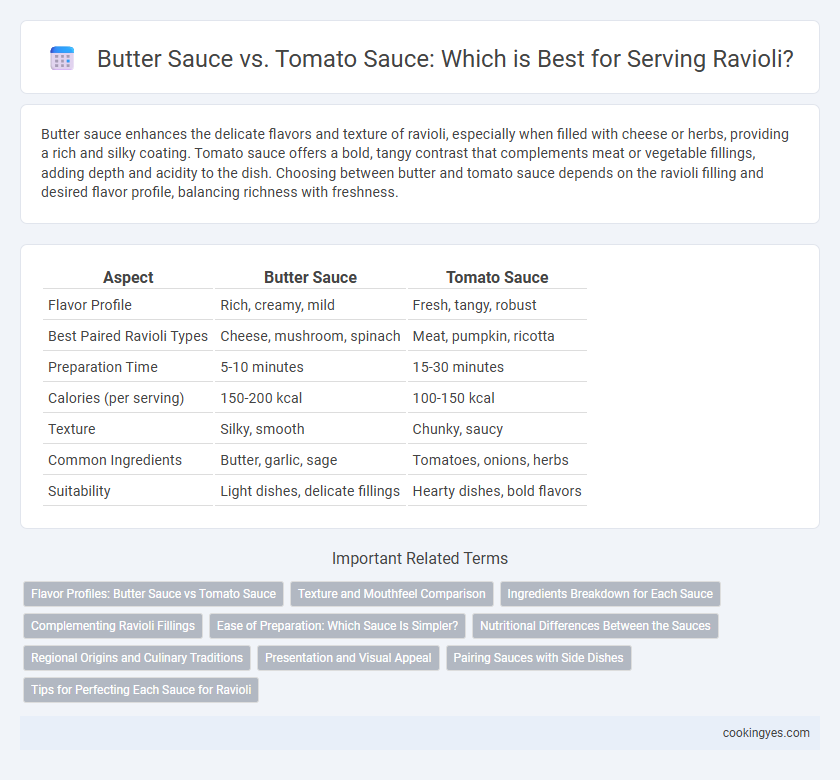Butter sauce enhances the delicate flavors and texture of ravioli, especially when filled with cheese or herbs, providing a rich and silky coating. Tomato sauce offers a bold, tangy contrast that complements meat or vegetable fillings, adding depth and acidity to the dish. Choosing between butter and tomato sauce depends on the ravioli filling and desired flavor profile, balancing richness with freshness.
Table of Comparison
| Aspect | Butter Sauce | Tomato Sauce |
|---|---|---|
| Flavor Profile | Rich, creamy, mild | Fresh, tangy, robust |
| Best Paired Ravioli Types | Cheese, mushroom, spinach | Meat, pumpkin, ricotta |
| Preparation Time | 5-10 minutes | 15-30 minutes |
| Calories (per serving) | 150-200 kcal | 100-150 kcal |
| Texture | Silky, smooth | Chunky, saucy |
| Common Ingredients | Butter, garlic, sage | Tomatoes, onions, herbs |
| Suitability | Light dishes, delicate fillings | Hearty dishes, bold flavors |
Flavor Profiles: Butter Sauce vs Tomato Sauce
Butter sauce enhances ravioli with a rich, creamy texture and subtle nutty notes that complement delicate fillings like cheese or mushrooms, creating a smooth and indulgent flavor profile. Tomato sauce offers a tangy, vibrant acidity with herbal undertones that balance heartier fillings such as meat or spinach, adding a bright and robust dimension to the dish. Choosing between butter and tomato sauce depends on the desired taste contrast and the specific ravioli filling to achieve optimal flavor harmony.
Texture and Mouthfeel Comparison
Butter sauce provides a rich, velvety texture that enhances the delicate, pillowy softness of ravioli, creating a smooth and creamy mouthfeel. In contrast, tomato sauce offers a slightly thicker, chunkier consistency with a tangy, robust flavor that complements the pasta's tender bite while adding a vibrant acidity. The choice between butter and tomato sauce significantly influences the overall eating experience, balancing richness and freshness in different ways.
Ingredients Breakdown for Each Sauce
Butter sauce for ravioli primarily consists of melted butter, garlic, and fresh herbs like sage or parsley, delivering a rich and creamy texture that complements delicate pasta fillings. Tomato sauce typically combines crushed tomatoes, olive oil, garlic, onions, and basil, offering a tangy and robust flavor profile with higher acidity and a heartier consistency. The choice between these sauces depends on the ravioli filling, with butter sauce enhancing mild cheeses and vegetables, while tomato sauce pairs well with meat or robust cheese varieties.
Complementing Ravioli Fillings
Butter sauce enhances delicate ravioli fillings like cheese, spinach, or mushrooms by providing a rich, creamy texture that allows the flavors to shine without overpowering them. Tomato sauce complements heartier fillings such as meat or sausage by adding acidity and robust flavor, balancing the richness and adding depth to each bite. Choosing the sauce based on the filling ensures a harmonious flavor profile that elevates the ravioli experience.
Ease of Preparation: Which Sauce Is Simpler?
Butter sauce is simpler to prepare for ravioli, requiring only melted butter and optional herbs, making it quick and hassle-free. Tomato sauce involves simmering tomatoes with garlic, onions, and spices, which takes more time and effort. For a fast and easy meal, butter sauce is the ideal choice.
Nutritional Differences Between the Sauces
Butter sauce for ravioli provides higher saturated fat and calories due to its dairy content, contributing to a richer, creamier texture. Tomato sauce is lower in calories and saturated fat but offers a significant amount of antioxidants such as lycopene, which supports heart health and reduces inflammation. Choosing between these sauces can impact overall nutrient intake, with butter sauce increasing fat and calorie density, while tomato sauce enhances vitamin and antioxidant consumption.
Regional Origins and Culinary Traditions
Butter sauce and tomato sauce for ravioli reflect distinct regional origins and culinary traditions in Italian cuisine. Northern Italy, especially regions like Lombardy and Piedmont, traditionally pairs ravioli with rich butter and sage sauce, emphasizing delicate flavors and creamy textures. Southern Italian regions such as Campania and Sicily favor vibrant tomato-based sauces that highlight bold, tangy, and herb-infused profiles, aligning with Mediterranean ingredients and rustic cooking styles.
Presentation and Visual Appeal
Butter sauce enhances ravioli's presentation with a glossy, golden sheen that highlights the pasta's texture and intricate folds, creating an elegant, minimalist visual appeal. Tomato sauce offers vibrant, rich red hues that contrast boldly with the pale ravioli, adding a rustic, colorful vibrancy that draws attention to the dish. The smooth, bright butter sauce emphasizes delicate sophistication, while the thick, chunky tomato sauce provides a hearty, visually dynamic experience.
Pairing Sauces with Side Dishes
Butter sauce, with its rich and creamy texture, pairs exceptionally well with delicate ravioli fillings like cheese or mushroom, enhancing the subtle flavors without overpowering them. Tomato sauce, characterized by its tangy and vibrant profile, complements meat or vegetable-filled ravioli by providing a robust contrast that balances the dish. Both sauces benefit from side dishes such as garlic bread or a fresh green salad, which add textural variety and cleanse the palate between bites.
Tips for Perfecting Each Sauce for Ravioli
Butter sauce for ravioli requires gentle heating to prevent browning and should be infused with fresh herbs like sage or thyme for enhanced aroma. Tomato sauce demands slow simmering with ripe tomatoes, garlic, and a pinch of sugar to balance acidity and achieve a rich, velvety texture. Both sauces benefit from finishing with a sprinkle of Parmesan cheese and a drizzle of high-quality olive oil to elevate the flavor profile.
Butter sauce vs Tomato sauce for ravioli serving Infographic

 cookingyes.com
cookingyes.com